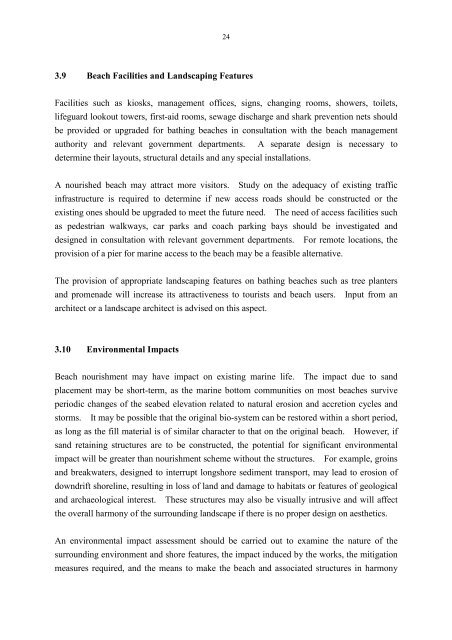PORT WORKS DESIGN MANUAL PART 5 Guide to Design of ...
PORT WORKS DESIGN MANUAL PART 5 Guide to Design of ...
PORT WORKS DESIGN MANUAL PART 5 Guide to Design of ...
You also want an ePaper? Increase the reach of your titles
YUMPU automatically turns print PDFs into web optimized ePapers that Google loves.
24<br />
3.9 Beach Facilities and Landscaping Features<br />
Facilities such as kiosks, management <strong>of</strong>fices, signs, changing rooms, showers, <strong>to</strong>ilets,<br />
lifeguard lookout <strong>to</strong>wers, first-aid rooms, sewage discharge and shark prevention nets should<br />
be provided or upgraded for bathing beaches in consultation with the beach management<br />
authority and relevant government departments. A separate design is necessary <strong>to</strong><br />
determine their layouts, structural details and any special installations.<br />
A nourished beach may attract more visi<strong>to</strong>rs. Study on the adequacy <strong>of</strong> existing traffic<br />
infrastructure is required <strong>to</strong> determine if new access roads should be constructed or the<br />
existing ones should be upgraded <strong>to</strong> meet the future need. The need <strong>of</strong> access facilities such<br />
as pedestrian walkways, car parks and coach parking bays should be investigated and<br />
designed in consultation with relevant government departments. For remote locations, the<br />
provision <strong>of</strong> a pier for marine access <strong>to</strong> the beach may be a feasible alternative.<br />
The provision <strong>of</strong> appropriate landscaping features on bathing beaches such as tree planters<br />
and promenade will increase its attractiveness <strong>to</strong> <strong>to</strong>urists and beach users. Input from an<br />
architect or a landscape architect is advised on this aspect.<br />
3.10 Environmental Impacts<br />
Beach nourishment may have impact on existing marine life. The impact due <strong>to</strong> sand<br />
placement may be short-term, as the marine bot<strong>to</strong>m communities on most beaches survive<br />
periodic changes <strong>of</strong> the seabed elevation related <strong>to</strong> natural erosion and accretion cycles and<br />
s<strong>to</strong>rms. It may be possible that the original bio-system can be res<strong>to</strong>red within a short period,<br />
as long as the fill material is <strong>of</strong> similar character <strong>to</strong> that on the original beach. However, if<br />
sand retaining structures are <strong>to</strong> be constructed, the potential for significant environmental<br />
impact will be greater than nourishment scheme without the structures. For example, groins<br />
and breakwaters, designed <strong>to</strong> interrupt longshore sediment transport, may lead <strong>to</strong> erosion <strong>of</strong><br />
downdrift shoreline, resulting in loss <strong>of</strong> land and damage <strong>to</strong> habitats or features <strong>of</strong> geological<br />
and archaeological interest. These structures may also be visually intrusive and will affect<br />
the overall harmony <strong>of</strong> the surrounding landscape if there is no proper design on aesthetics.<br />
An environmental impact assessment should be carried out <strong>to</strong> examine the nature <strong>of</strong> the<br />
surrounding environment and shore features, the impact induced by the works, the mitigation<br />
measures required, and the means <strong>to</strong> make the beach and associated structures in harmony

















